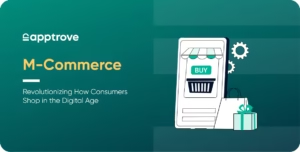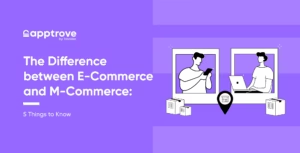Remember when online shopping meant hunching over a desktop, watching loading bars creep across the screen, and praying your order wouldn’t time out? Those days feel like ancient history now. Today, your phone handles everything, from weekly groceries to haircut appointments and concert tickets, often before you’ve even finished your morning coffee. That is the magic of M commerce: lightning-fast, intuitive, and completely transforming how we shop and spend.
As this seismic shift unfolds, businesses everywhere are reimagining how they connect with customers, starting with smarter, more strategic mobile approaches. From fine-tuning user journeys to diving deep into mobile behavior patterns, brands are embracing performance-driven mobile marketing to stay relevant in our increasingly mobile-first world. You can read more on how M-Commerce is revolutionizing shopping here. According to Statista’s projections, M-Commerce will represent a staggering 63% of all global eCommerce sales by 2028. But while the opportunities are enormous, the challenges are just as significant.
As we explore the 8 advantages and disadvantages of M-Commerce, businesses must understand both the benefits and the pitfalls of this mobile revolution to navigate it successfully.
What Even Is Mobile Commerce Anyway?
When we talk about “M-Commerce,” we mean all those purchases you make through your mobile and tablet. It’s not just regular eCommerce shrunk down to fit your phone screen. It’s an entirely different experience designed specifically for those moments when you’re waiting for the bus or lying in bed at night (come on, we all know you do a little late-night shopping, right?).
Think about it – shopping through apps, buying stuff directly through Instagram, and paying with a quick fingerprint scan. That’s Mobile Commerce in action, and it’s completely changed how you think about shopping.
Why Embracing the Advantages of M-Commerce Is Crucial for Growth
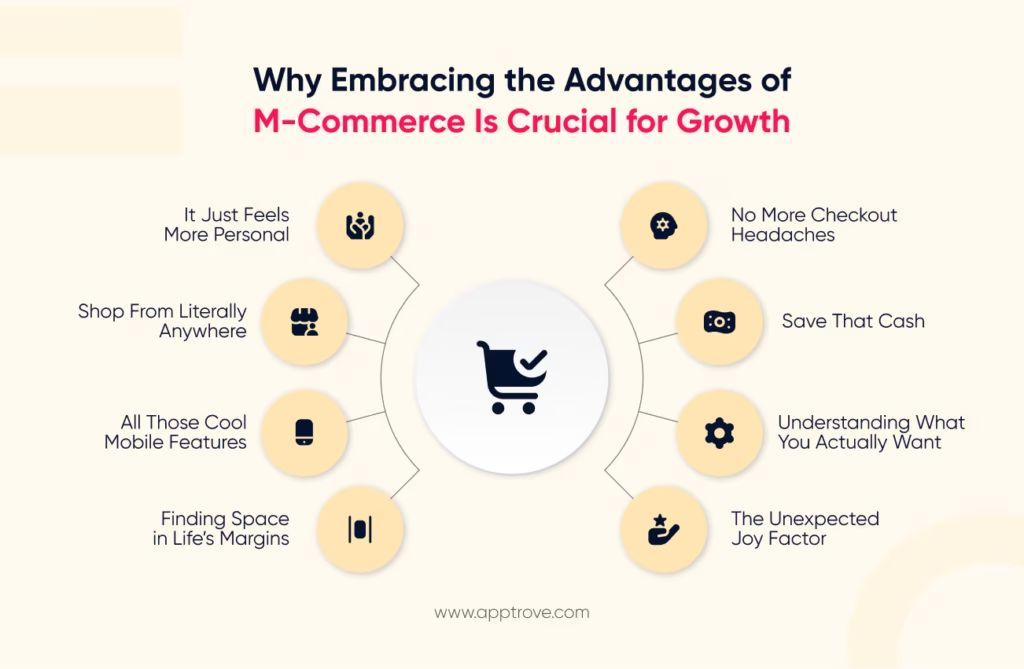
1. It Just Feels More Personal – A Key M-Commerce Advantage
When you’re shopping on your phone, the best apps seem to just “get you.” They remember what you’ve looked at, suggest things you might actually want, and don’t bombard you with random stuff. That personalization isn’t accidental – Mobile Commerce makes it possible to create shopping experiences that feel like they were made just for you.
2. No More Checkout Headaches – Mobile Shopping Made Simple
Remember filling out those endless forms with your address, credit card, and firstborn child just to buy something online? Yeah, mobile shopping has pretty much killed those off. Now it’s just your thumbprint, face scan, or one tap, and boom, done! No wonder you’re actually completing your purchases instead of abandoning your cart in frustration.
3. Shop Wherever Life Takes You – The Convenience of M commerce
You’ve probably bought things while hiking (no judgment), waiting in line at coffee shops, and sitting in airport lounges. With M-Commerce, geography doesn’t matter anymore. You can buy from a small business in Nebraska while you’re sitting in Tokyo just as easily as from a shop down your street.
4. Save That Cash – A Smarter Way to Scale Your Business
Let’s be honest, opening physical stores costs a fortune. Building an amazing mobile shopping experience? Way more affordable. If you’re running a business and looking to grow without draining your bank account, Mobile Commerce is the way to go.
5. Why Mobile Shopping Feels So Smooth – It’s All in the Features
Don’t you love those push notifications that remind you about the shoes you were eyeing? Or location alerts that offer you a discount when you walk past a store? How about virtual try-ons for glasses before you buy? These mobile-specific features make your shopping more interactive and, dare we say, fun!
6. Understanding What You Actually Want – The Data-Driven Benefit
Here’s the truth – your phone knows you better than some of your friends do. The data gathered through mobile shopping helps businesses understand what you really want, not just what you say you want.
7. Making the Most of Life’s In-Between Moments
Mobile shopping transforms those fleeting moments, waiting in line or between tasks, into productive opportunities. Rather than letting these brief windows slip away, you can shop on the go, seamlessly fitting convenience into your unpredictable schedule. It’s about making the most of your time wherever you are, accomplishing more without disrupting your daily rhythm.
8. Why Shopping on Your Phone Feels So Good
Who knew shopping could actually be enjoyable? The thoughtful interactions, that satisfying swipe, the subtle vibration when you add something to your cart, and the playful animations that celebrate your purchase, create moments of delight that brick-and-mortar stores rarely match. Your shopping becomes less of a task and more of an experience.
The 8 Disadvantages of M-Commerce: What You Should Know
But let’s get real – as convenient as it is, Mobile Shopping isn’t flawless. There are real concerns you should know about when exploring the advantages and disadvantages of M-commerce.
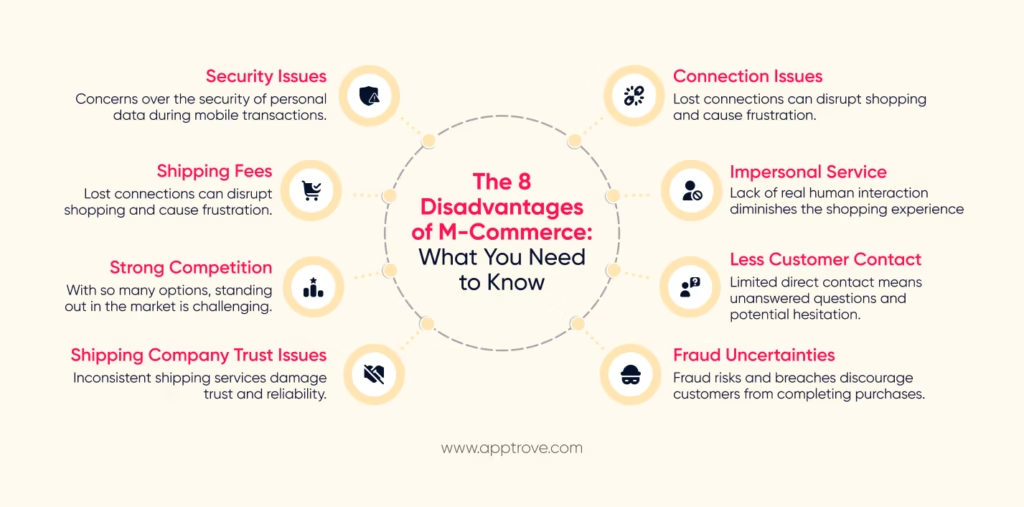
1. Security Issues – The Trust Barrier in Online Shopping
Have you ever hesitated before typing in your credit card details on your phone? You’re not alone. You might feel reluctant to share your personal data with brands due to security concerns. Think about it, when you’re asked for your credit card number and bank account information to process an online purchase, don’t you wonder if your data is truly safe? This trust barrier remains one of the biggest hurdles for you to overcome when using M-Commerce.
2. Connection Issues – The Accessibility Issue
Picture this: you’ve found the perfect item, your cart is loaded, and just as you hit “purchase,” your signal drops. Frustrating, right? When you’re shopping online, you absolutely need internet service to complete your purchase. And while internet access is more widely available these days, you’ll still hit countless dead zones, especially in suburban areas. Without a proper connection, you can’t access mobile shopping sites, and businesses lose their potential sale. You know that panic when the loading icon spins endlessly at checkout?
3. Hidden Costs – The Shipping Fee Factor
That $20 shirt suddenly becomes a $27 purchase once shipping gets added, talk about a mood killer! Any mobile transaction you make to purchase a physical product often comes with additional shipping fees that can make you second-guess your purchase. You’ve probably noticed some smart retailers combating this by establishing minimums for free delivery and keeping shipping costs low, which encourages you to keep shopping. Have you ever added something extra to your cart just to hit that free shipping threshold? Yeah, we thought so.
4. Lack of Personal Touch – The Human Element Missing
Mobile shopping sacrifices the human touch that makes retail special. While algorithms suggest products, they can’t replace a store associate who remembers your preferences and responds to your needs in real time. That personal connection gets lost behind the screen.
5. Strong Competition – The Differentiation Disadvantage of M-Commerce
Have you noticed how most shopping apps start to look the same after a while? As more businesses compete for your attention, standing out becomes increasingly difficult. Unlike traditional stores, which often have unique atmospheres or signature elements that make them memorable to you, Mobile Shopping sites can easily blend together in a sea of sameness. With everyone fighting for your attention on that small screen in your hand, creating a distinct brand experience becomes much harder for businesses, but also much more important for winning your loyalty.
6. Limited Customer Interaction – The Relationship Drawback of Mobile Shopping
Ever had a question about a product that the description just doesn’t answer? In traditional shopping, you’d simply ask a salesperson. With M-Commerce, you place orders after reading specifications and product features, but there’s minimal interaction with actual sellers. If you have doubts or specific questions, they often aren’t addressed in the most helpful way. This distance between you and the seller is why you might sometimes prefer offline purchases, you want that human connection and immediate answers.
7. Unreliable Shipping – A Major Fulfillment Disadvantage of M-Commerce
You’ve been there, tracking shows your package was delivered, but there’s nothing at your door. When you frequently use Mobile Shopping apps, you’ve probably encountered a range of shipping companies with varying reliability. Sometimes your items arrive perfectly on time; other times, they’re late, damaged, or missing altogether. When you blindly trust shipping partners without proper vetting, you might face problems that damage not just your shopping experience but potentially a business’s reputation as well.
8. Fraud Uncertainties – The Security Disadvantage of Mobile Commerce
You know that uneasy feeling when you enter your banking information on a new site? It’s valid. The prevalence of fraud and security breaches remains the number one drawback that might make you hesitate about Mobile Shopping. You might avoid M-commerce entirely, not because it’s inconvenient, but out of legitimate fear. When you see reports of data breaches make headlines every few months, it’s no wonder you might prefer the security of physical transactions where your digital footprint isn’t at risk.
Conquering Mobile Commerce: Turning the Advantages and Disadvantages of M-Commerce to Your Favor
Think Mobile-First, Not Desktop First
If you’re a business owner, design for thumbs and small screens from the beginning- don’t just shrink down your eCommerce website and call it a day. True M-Commerce starts with mobile-first thinking about your customers’ experience.
Make Everything Work Together
You should be able to start shopping on an app, continue on a website, and maybe even finish in a physical store without any hiccups. Your shopping journey shouldn’t feel fragmented.
Use All Those Cool Mobile Features
If your phone can do it, your shopping experience should use it- location services, cameras for virtual try-ons, and push notifications that actually help you. Your technology should work for you, not against you.
Learn From Your Data
Every tap, swipe, and purchase tells your story. The businesses that pay attention to these stories can create better experiences just for you.
By embracing performance-driven mobile marketing strategies, businesses can better understand user behavior and optimize their approach, ultimately driving more sales and loyalty from their mobile users.
What’s Coming Next in M-Commerce For You?
If you think Mobile Commerce is already convenient, wait till you see what’s coming to your phone next. You’re heading into a future where shopping from your phone feels less like an errand and more like second nature. And with mobile sales projected to hit $2.5 trillion globally by 2025, the pace of innovation in your shopping experience isn’t slowing down anytime soon. Here’s a quick peek at what’s around the corner for you:
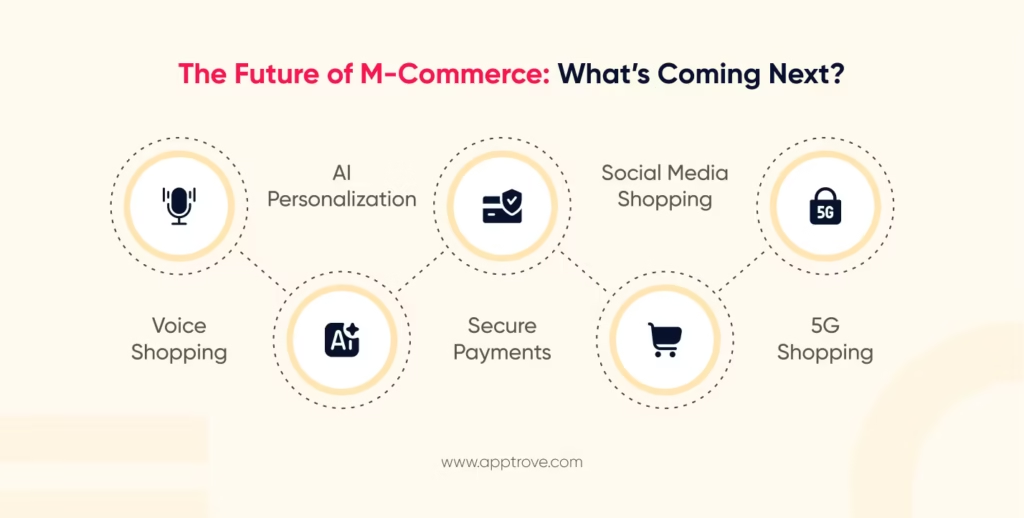
“Hey Alexa, Order My Usual Coffee Beans”
Voice shopping is quickly becoming your go-to for convenience. In fact, 43% of consumers like you are supposed to use voice assistants to make purchases, and that number keeps climbing. Whether you’re reordering pet food or grabbing last-minute gifts, your hands-free shopping is getting more natural and a lot more popular.
AI That Understands Not Just What You Buy, But Why You Buy It
By 2030, Global AI in the retail market is expected to expand by $164.74 billion. What does that mean for your Mobile Commerce experience? Smarter, more personalized recommendations that go way beyond “you might also like…” Imagine having a shopping assistant who knows you skip Monday sales but always clicks on Saturday evening deals. Yep, your shopping is getting that personalized.
More Secure Ways to Pay That Give You Peace of Mind
Security remains your top concern in mobile commerce, with over 42% of users expressing worries about data privacy. That’s where blockchain is stepping in, offering you encrypted and tamper-proof payment systems that make checkout both smarter and safer. It’s not just about convenience anymore- it’s about your peace of mind.
The Line Between Your Scrolling and Shopping Is Disappearing Fast
Nearly 97% of Gen Z consumers use social media as their primary source of shopping inspiration. And now, platforms like Instagram, TikTok, and Pinterest are cutting out the middleman, letting you discover, evaluate, and purchase products right from your feed. Your scroll-to-buy journey feels as natural as double-tapping a photo.
Faster Connections Mean Smoother, Richer Shopping Experiences For You
5G isn’t just about faster Netflix- it’s about totally leveling up how you shop on your phone. With North America expected to hit 89% 5G adoption by 2030, you’re looking at buttery-smooth experiences: no buffering, instant product previews, real-time AR try-ons, and checkouts that are over before you blink. Basically, all the perks of mobile shopping are that it is just way faster and way more fun for you.
Conclusion: Balancing the Advantages and Disadvantages of M-Commerce in Your Life
Mobile Commerce isn’t some futuristic concept- it’s how you shop right now. The businesses that get this and create amazing mobile experiences are the ones that will win your loyalty.
If you’re running a business, your time to go all-in on the benefits of Mobile Commerce isn’t tomorrow, it’s yesterday. And with partners like Apptrove providing the attribution tools and insights you need to optimize your mobile strategy, there’s no reason to delay. The platform helps you understand exactly how customers interact with your mobile presence, turning data into actionable improvements.
And for you as a shopper? Well, your life just keeps getting more convenient, one tap at a time.
The mobile shopping revolution is already happening in your hands. The only question is: Are you making the most of M-Commerce’s advantages while minimizing the disadvantages?



